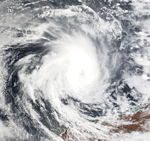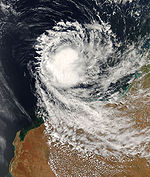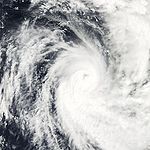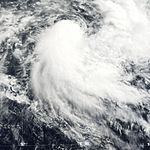- 2007–08 Australian region cyclone season
-
2007–08 Australian region cyclone season 
Season summary mapFirst storm formed: 27 July 2007 Last storm dissipated: 25 April 2008 Strongest storm: Pancho – 934 hPa (mbar), 175 km/h (110 mph) (10-minute sustained) Tropical lows: 23 Tropical cyclones: 9 Severe tropical cyclones: 3 Total fatalities: 170 Total damage: $86 million (2008 USD) Australian region cyclone seasons
2005–06, 2006–07, 2007–08, 2008–09, 2009–10Related articles: - Timeline of the 2007–08 Australian region cyclone season
- 2007–08 South-West Indian Ocean cyclone season
- 2007–08 South Pacific cyclone season
The 2007–08 Australian region cyclone season got off to an early start with the formation on 27 July of the first Tropical Cyclone which was not upgraded operationally to a cyclone but was later upgraded to a Cyclone during post storm analysis. This was the second time that a tropical Cyclone had formed during the month of July. The other one was Cyclone Lindsay in the 1996–1997 season. The next cyclone that formed was Cyclone Guba which formed on 13 November with TCWC Port Moresby assigning the name Guba on 14 November which was the first named storm within TCWC Port Moresby's area of responsibility since Cyclone Epi in June 2003. Guba was also the first cyclone to occur in the Queensland region in the month of November since 1977.
Tropical Cyclone Lee also formed on 13 November and was named by TCWC Perth on 14 November with it moving into RSMC Réunion's area of responsibility and being renamed Ariel. The next Cyclone to form within the Australian region was Melanie which formed on 27 December and was named on the 28th by TCWC Perth. Melanie was the first storm of the season which required Cyclone watches and warnings were issued for the Pilbara coast however it had weakened into a low pressure area before it made landfall.
Tropical Cyclone Helen was the first Tropical Cyclone to form in 2008 in the Southern Hemisphere which formed in TCWC Darwin's area of responsibility and was the first time that Darwin had experienced a tropical cyclone since Tropical Cyclone Gretel in the 1984–85 season.[1] Cyclone Nicholas made landfall north of Carnarvon on 20 February as a category one cyclone. Cyclone Ophelia actually formed in TCWC Darwin's area of responsibility but had moved into TCWC Perth's area when it was named. Tropical Cyclone Pancho formed on 23 March south of Christmas Island and was named by TCWC Perth on 25 March and reached Category 4 status with winds of 95 kn (176 km/h).
In April 2008 Tropical Cyclones Rosie and Durga were the first ever Tropical Depressions to be monitored within TCWC Jakarta's area of responsibility and Durga was also the first storm to reach Tropical cyclone status and named whilst being monitored by TCWC Jakarta. Durga was also the last storm of the season which officially ended on 30 April.
Storms
Tropical Cyclone 01U
Category 1 tropical cyclone (Australian scale) Tropical storm (SSHS) 

Duration 27 July – 31 July Intensity 75 km/h (45 mph) (10-min), 992 mbar (hPa) On 29 July an area of low pressure close to the edge off RSMC La Reunions Area of responsibility, was designated as Tropical Disturbance 01R, by the RSMC in La reunion.[2] However this number was withdrawn in RSMC La reunions post storm Analysis.[3] The JTWC issued a Tropical Cyclone Formation Alert (TCFA) on the developing system on 29 July [4] and initiated warnings on the tropical cyclone late that day designating it as Tropical cyclone 01S.[5] However by this time the cyclone had crossed 90E and had crossed into TCWC Perth's Area of Responsibility, who designated it as a Tropical Low and issued shipping warnings on the Tropical Low.[3] Early on 30 July The Cyclone began to dissipate so the JTWC issued their final advisory that day.[6] and the Bureau of Meteorology issued its last warning the next day.[3]
During Post storm analysis The Bureau of Meteorology upgraded the Tropical low to a tropical cyclone in its post-storm analysis, with maximum 10-min sustained winds of 75 km/h (45 mph) based on QuikSCAT observations. The cyclone's intensity was estimated to have reached cyclone intensity from 29 July to 30 July.[3]
The cyclone is the second on record to exist in the Western Australian region in July, the other being Cyclone Lindsay in 1996.[3]
Tropical Cyclone Lee-Ariel
Category 2 tropical cyclone (Australian scale) Tropical storm (SSHS) 

Duration 13 November – 15 November Intensity 95 km/h (60 mph) (10-min), 984 mbar (hPa) On 13 November, the Tropical Cyclone Warning Centre (TCWC) in Perth began issuing warnings on a developing tropical low which was located within the area of responsibility of TCWC Jakarta.[7] On 14 November, TCWC Perth upgraded the Tropical Low to Tropical Cyclone Lee, while the cyclone was still in TCWC Jakarta's area of responsibility.[8] Later that day the Joint Typhoon Warning Center (JTWC) issued a Tropical Cyclone Formation Alert on Tropical Cyclone Lee,[9] and then designated the storm as Tropical Cyclone 03S shortly after.[10] The TCWC in Perth upgraded Lee to a Category 2 on 15 November. Later that day, TCWC Perth issued its final advisory on Lee as it crossed west of 90°E,[11] and the system was renamed Severe Tropical Storm Ariel by the Sub-Regional Tropical Cyclone Advisory Centre in Mauritius; see 2007–08 South-West Indian Ocean cyclone season.[12]
Severe Tropical Cyclone Guba
Category 3 severe tropical cyclone (Australian scale) Category 1 tropical cyclone (SSHS) 

Duration 13 November – 19 November Intensity 140 km/h (85 mph) (10-min), 970 mbar (hPa) Main article: Cyclone GubaThe Tropical Cyclone Warning Centre (TCWC) in Brisbane began issuing warnings on a developing tropical low which was located near the southern Papua New Guinea mainland on 13 November 2007,[13] while the Joint Typhoon Warning Center (JTWC) issued a Tropical Cyclone Formation Alert on the storm.[14] Later that day, the JTWC issued its first advisory, designating the low as Tropical Cyclone 02P.[15] TCWC Brisbane initiated tropical cyclone advices on the tropical low early on 14 November. Shortly after, TCWC Brisbane upgraded the system to Tropical Cyclone Guba, which was a name assigned by the TCWC in Port Moresby.[16] Guba drifted erratically off the Queensland coast for the next two days, and intensified on 16 November, becoming a Category 3 severe tropical cyclone. Guba was a small, but intense system, forming a well-defined eye. Guba began weakening on 17 November as it started to accelerate to the west towards the Queensland coast. However, it later turned northwards, avoiding the Australian mainland, then north-east while it continued to weaken. TCWC Brisbane downgraded Guba below tropical cyclone strength, and issued its last advisory early on 20 November.
Flooding in Papua New Guinea led to at least 150 deaths.[17] In the Oro Province, about 2,000 people were evacuated as a result of the flooding.[18] Roads, bridges and 40 houses were washed away, as tides in the area reached two metres high.[19] The provincial capital, Popondetta, had its water supply shut down, and Papua New Guinea's national airline, Air Niugini, suspended flights to Popondetta's main airport. The Rabaraba district in Milne Bay Province was also hit by flooding, with 30 houses and food gardens washed away, and forcing the evacuation of about 100 people.[18] The government in Papua New Guinea reported that an estimated 145,000 people were affected from the flooding in Oro Province.[20] Six days of torrential rain led to a damage total of 200 million kina ($71.4 million USD). Guba was the first tropical cyclone to be assigned a name from Port Moresby's name lists since Tropical Cyclone Epi in 2003. It is the first cyclone to occur in the Queensland region in the month of November since 1977.[21]
Tropical Low 04U
Tropical low (Australian scale) 

Duration 21 December – 22 December Intensity 55 km/h (35 mph) (10-min), 998 mbar (hPa) On 18 December, a Tropical Depression in the south-west Indian Ocean was named Moderate Tropical Storm Dama, monitored by Météo France. The system then moved south-east, entering the area of responsibility of Perth's Tropical Cyclone Warning Centre, east of 90°E. The storm however, was not at Tropical Cyclone strength when it crossed the area, but was still a tropical depression, in which the Perth TCWC began issuing shipping warnings.
Tropical Cyclone Melanie
Category 2 tropical cyclone (Australian scale) Tropical storm (SSHS) 

Duration 28 December – 2 January Intensity 110 km/h (70 mph) (10-min), 962 mbar (hPa) On 27 December, the Tropical Cyclone Warning Centre (TCWC) in Perth identified a Tropical Low near 11.2°S and 117.2°E, and began issuing shipping warnings for the developing system.[22] Early on 28 December, the TCWC in Perth upgraded the tropical low to a tropical cyclone and named it Melanie.[23] The cyclone moved southwards, then turned to the south-west on 29 December and strengthened to a Category 2 (Australian scale).[24] Cyclone watches and warnings were issued for the Pilbara coast. On 30 December Melanie began to weaken and become less organised. Melanie continued to weaken and the system was downgraded to Category 1 status on 31 December. Continued weakening took place thereafter and it weakened below cyclone status early on 2 January, when the final advisory was issued.[25]
Tropical Cyclone Helen
Category 2 tropical cyclone (Australian scale) Tropical storm (SSHS) 

Duration 28 December – 6 January Intensity 95 km/h (60 mph) (10-min), 975 mbar (hPa) Main article: Tropical Cyclone HelenIn late December a tropical low formed over the Top End which was slow moving in the eastern Top End on 29 December, which began moving west during 1 January at the base of the Top End. By the evening of 2 January the Tropical low moved into the Joseph Bonaparte Gulf.[26] On 3 January at 11 am ACST (0130 UTC) the TCWC in Darwin, Australia, located near the edge of their Area of Responsibility, with TCWC Perth, declared a Tropical Cyclone Warning for the coastal areas from Mitchell Plateau in Western Australia to the Daly River Mouth in Northern Territory with a Tropical Cyclone Watch declared for coastal areas from the Daly River Mouth to Goulburn Island which also included Darwin.[26][27] Later that day a TCFA was issued by the JTWC who then upgraded the low to a Tropical Cyclone designating the cyclone 10S later that day.[28][29] On 4 January at 8 am ACST (2230 UTC), TCWC Darwin upgraded the Tropical Cyclone Warning to included Darwin, by 11am ACST (0103 UTC) the TCWC Darwin upgraded the Tropical low to Tropical Cyclone Helen which was located 380 km to the west/south west of Darwin moving towards the north East.[26][30] During the afternoon of 4 January Tropical Cyclone Helen was steadily moving towards the east to the Daly River Mouth region, Approximately 7pm ACST (0930 UTC) TCWC Darwin upgraded the intensity to 50 knots (Category 2), making landfall at Channel Point approximately 130 km southwest of Darwin at 10pm ACST (1230 UTC),[26][31] started to weaken due to interaction with land with it weakening in to a tropical low on 5 January as it had become less organised.[32] on 6 January the JTWC issued its final warning on Tropical Cyclone Helen,[33] and then later that day TCWC Darwin followed suit and issued its final advisory on Tropical Low Ex-Helen as it approached TCWC Brisbane's Area of Responsibility.[34]
The strongest wind gust recorded was at Charles Point Lighthouse with 120 kilometres an hour recorded during the Tropical Cyclone with Darwin Airport recording 102 kilometres an hour around 2 am ACST making it the first time since April 1985 for Darwin to experience Category 1 or more since Tropical Cyclone Gretel past Darwin on 12 April 1985.[26][35][36] Damages from the storm amounted to an estimated A$21.5 million ($15 million USD).[37]
Tropical Low 07U
Tropical low (Australian scale) 
Duration 31 December – 2 January Intensity 55 km/h (35 mph) (10-min), 994 mbar (hPa) On 31 December, the Tropical Cyclone Warning Centre (TCWC) in Perth identified a Tropical Low north north-west of the Cocos Islands, and began issuing shipping warnings.[38] The low then moved south-west for the next few days, where it proceeded to enter an area of high vertical wind shear, and began to rapidly weaken. The TCWC issued its final shipping warning on 2 January.[39]
Tropical Low (17S)
Tropical low (Australian scale) Tropical storm (SSHS) 

Duration 4 February – 10 February Intensity 55 km/h (35 mph) (10-min), 990 mbar (hPa) On 4 February, the Tropical Cyclone Warning Centre (TCWC) in Perth identified a Tropical Low South west of Christmas Island, and began issuing shipping warnings.[40] Initially it was thought that it was going to intensify into a tropical Cyclone but later on 4 February, The cyclone began to weaken with the final gale warnings being issued by TCWC Perth later that day. Over the next few days the system drifted eastwards and then on 6 February began showing signs of intensification.[41] The Following day, the Joint Typhoon Warning Center (JTWC) issued its first advisory, designating the low as Tropical Cyclone 17S.[42] Later that day TCWC Perth reinstated Gale warnings on the tropical low.[41] On 10 February The TCWC Perth and the JTWC issued their final advisories on the system.[43]
Severe Tropical Cyclone Nicholas
Category 3 severe tropical cyclone (Australian scale) Category 1 tropical cyclone (SSHS) 

Duration 10 February – 20 February Intensity 150 km/h (90 mph) (10-min), 948 mbar (hPa) On 10 February, the Tropical Cyclone Warning Centre (TCWC) in Perth identified a Tropical Low near 16.0°S and 124.7°E, and began issuing tropical cyclone advices on the system.[44] On 12 February, the Joint Typhoon Warning Center (JTWC) issued a Tropical Cyclone Formation Alert on the developing system.[45] Later in the day, the JTWC issued its first advisory, designating it as Tropical Cyclone 19S.[46] Early on 13 February, the Tropical Cyclone Warning Centre in Perth upgraded the tropical low to a tropical cyclone and named it "Nicholas".[47][48] On 16 February, Nicholas was upgraded to a Severe Tropical Cyclone,[49] but it was downgraded back to a tropical cyclone on 18 February.[50] Nicholas squirmed around Western Australia before finally making landfall north of Carnarvon on 20 February.[51] Once inland, TCWC Perth discontinued advisories.[52] The cyclone caused gales over the North West cape in Western Australia, and the town of Exmouth was on high alert.[53]
Tropical Cyclone Ophelia
Category 2 tropical cyclone (Australian scale) Category 1 tropical cyclone (SSHS) 

Duration 27 February – 7 March Intensity 100 km/h (65 mph) (10-min), 985 mbar (hPa) On 27 February 2008 the Tropical Cyclone Warning Centre (TCWC) in Darwin identified a Tropical Low near the Northern Territory, and began issuing tropical cyclone advices on the system.[54] On 29 February, the JTWC issued a Tropical Cyclone Formation Alert on the developing system.[55] On 1 March, the JTWC issued their first warning on Tropical Cyclone 21S.[56] The low moved into TCWC Perth's area of responsibility during the day. The low strengthened as it moved off the Kimberley coast, and was upgraded to Tropical Cyclone Ophelia by TCWC Perth.[57] Ophelia intensified to a Category 2 cyclone on the Australian scale early on 2 March. The JTWC briefly upgraded Ophelia to a Category 1 cyclone on the Saffir-Simpson Hurricane Scale later that day, but was downgraded to a tropical storm on the next advisory. Ophelia continued on a general south-westerly track parallel to the coast, and eventually weakened out to sea as TCWC Perth discontinued advisories.[58]
Tropical Low (20P)
Tropical low (Australian scale) Tropical storm (SSHS) 

Duration 29 February – 29 February Intensity 55 km/h (35 mph) (10-min), 999 mbar (hPa) Early on 28 February, Tropical Cyclone Warning Center Brisbane identified a Tropical low which was located about 100 nmi (190 km) north-east of Townsville, Queensland and started issuing Gale Warnings on the low [41] Later that day the Joint Typhoon Warning Center (JTWC) issued a Tropical Cyclone Formation Alert on this tropical low which was located north-east of Australia.[59] The next day, the JTWC issued its first advisory on the Tropical Low designating it as Tropical Cyclone 20P.[60] Later that day, the JTWC issued its final advisory on the system noting the storm was becoming extratropical.[61] However TCWC Brisbane continued to issue warnings on this Tropical Low as it approached the edge of Brisbane's Area off responsibility. On 1 March TCWC Brisbane issued its final Gale warning for the northern region as the Low moved into TCWC Wellingtons Area of responsibility.[62]
Severe Tropical Cyclone Pancho
Category 4 severe tropical cyclone (Australian scale) Category 3 tropical cyclone (SSHS) 

Duration 25 March – 29 March Intensity 175 km/h (110 mph) (10-min), 934 mbar (hPa) On 23 March a Tropical low formed south-west of Christmas Island.[63] The next day TCWC Perth, began issuing shipping warnings on the Tropical low.[64] Later that day the JTWC issued a Tropical Cyclone Formation Alert, on the tropical low. They then started issuing warnings that day designating it as Tropical Cyclone 26S.[65][66] The low then intensified in to a Tropical Cyclone and was named Pancho by TCWC Perth early on 25 March.[67]
The Next day Pancho became a severe tropical cyclone on the Australian scale,[68] with Pancho rapidly intensified in to a minimal Category four cyclone on the Australian scale on 27 March. However during the 28th, Tropical Cyclone Pancho entered an area of increasing vertical wind shear and cooler sea surface temperatures and within a few hours it was downgraded back to a Category 2 cyclone on the Australian scale.[69] The cyclone then weakened back to a tropical low about 300 kilometres south-west of the Western Australian Gascoyne coast with gale-force winds remaining south of the low. with both TCWC Perth and the JTWC issuing their final warnings on Pancho that day.[70][71]The remnants of Poncho produced much needed rains over the drought stricken areas of Western Australia. Mandurah, Garden Island, and Rottnest recorded the highest rainfall totals during the event at 56.4 mm (2.22 in), 49.8 mm (1.96 in) and 49.4 mm (1.94 in) respectively.[72] The heavy rains caused some flooding along several roads, forcing officials to temporarily shut them down. Large swells from the storm also washed rocks onto the roads near Exmouth.[73]
Tropical Cyclone Rosie
Category 2 tropical cyclone (Australian scale) Tropical storm (SSHS) 

Duration 18 April – 25 April Intensity 95 km/h (60 mph) (10-min), 988 mbar (hPa) Main article: Cyclone Rosie (2008)A tropical low formed south-west of Sumatra Indonesia, On 18 April.[74] The Tropical Cyclone Warning Centre (TCWC) in Jakarta then designated it as a Tropical Depression early on 20 April.[75] The next day as the Tropical Depression moved southwards the Joint Typhoon Warning Center (JTWC) issued a Tropical Cyclone Formation alert on the developing system,[76] and then later that day upgraded the tropical depression to Tropical Cyclone 28S.[77] On 22 April the Tropical Depression then moved into TCWC Perth's Area of responsibility and was upgraded to Tropical Cyclone Rosie.[78] On 23 April Rosie encountered high vertical wind shear and began weakening, being downgraded in the early hours of the next day to a tropical low.[79] The JTWC issued their last warning on the cyclone on 24 April as well.[80]
Tropical Cyclone Durga
Category 2 tropical cyclone (Australian scale) Tropical storm (SSHS) 

Duration 23 April – 25 April Intensity 95 km/h (60 mph) (10-min), 984 mbar (hPa) On 21 April The Joint Typhoon Warning Center (JTWC) identified a Tropical Disturbance which was located just inside Météo France's Area Of Responsibility (AOR) and issued a Tropical Cyclone Formation Alert on the developing system.[81] However, RSMC La Reunion did not monitor the storm. The disturbance then moved out of Météo France's AOR, and into TCWC Jakarta's AOR, who then designated it as a Tropical Depression on 22 April.[82] Later that day The JTWC initiated warnings on the Tropical Depression designating it as Tropical Cyclone 29S.[83] Early the next day TCWC Jakarta Assigned the name Durga to the cyclone.[84] The cyclone then weakened as it moved into TCWC Perth's area of responsibility, between Cocos and Christmas Islands. TCWC Perth then issued their final warnings on Ex Tropical Cyclone Druga as it was downgraded to a tropical low on 25 April.[85]
Storm names
Tropical cyclones in this area were monitored by five Tropical Cyclone Warning Centres (TCWCs): the Australian Bureau of Meteorology in Perth, Darwin, and Brisbane; TCWC Jakarta in Indonesia; and TCWC Port Moresby in Papua New Guinea.[86] The Joint Typhoon Warning Center also issues unofficial warnings for the region, designating tropical depressions with the "S" suffix when they form west of 135°E, and the "P" suffix when they form east of 135°E.[86]
Indonesia
Tropical cyclones that developed between the Equator and 10°S and between 90°E and 125°E were assigned names by the Tropical Cyclone Warning Centre in Jakarta, Indonesia.[86]
Durga Southeast Indian Ocean
Tropical cyclones that developed east of 90°E, south of 10°S, and west of 125°E were assigned names by the Tropical Cyclone Warning Centre in Perth, Western Australia.[86] 01S was monitored as a Tropical Low operationally but during post Storm Analysis was upgraded to tropical cyclone status by TCWC Perth.
01S Lee Melanie Nicholas Ophelia Pancho Rosie Arafura Sea and Gulf of Carpentaria
Tropical cyclones that developed south of the Equator between 125°E and 141°E were assigned names by the Tropical Cyclone Warning Centre in Darwin, Northern Territory.[86]
Helen Coral Sea
Tropical cyclones that developed south of 10°S between 141°E and 160°E were assigned names by the Tropical Cyclone Warning Centre in Brisbane, Queensland.[86]
No tropical cyclones formed in this area in this season.
Solomon Sea and Gulf of Papua
Tropical cyclones that develop north of 10°S between 141°E and 160°E were assigned names by the Tropical Cyclone Warning Centre in Port Moresby, Papua New Guinea.[86] Tropical cyclone formation in this area is rare, and prior to this season, no cyclones had developed in it since 2003.[87]
Guba Retired Names
At the 12th meeting of the RA V Tropical Cyclone Committee in Niue in July 2008, it was decided that the name Guba was retired from the TCWC Port Moresbys Naming lists this season as TCWC Port Moresby uses names only once and then they are retired. The name Malia was promoted from the standby list to replace the name Guba. The name Auram was added to the standby list in place of Malia. [88]
It was also decided that the 3 Australian Bureau of Meteorology naming lists would be merged into one main one list to be used within the whole of the Bureau of Meteorology's area of responsibility from the start of the 2008–09 tropical cyclone year. As a consequence all of the names being used in the 3 name lists were removed from the current list.[89]
See also
- List of Southern Hemisphere tropical cyclone seasons
- Atlantic hurricane seasons: 2007, 2008
- Pacific hurricane seasons: 2007, 2008
- Pacific typhoon seasons: 2007, 2008
- North Indian Ocean cyclone seasons: 2007, 2008
References
- ^ "Hurricane Season 2008:Tropical Cyclone Helen (Indian)". NASA. http://www.nasa.gov/mission_pages/hurricanes/archives/2008/h2008_helen.html. Retrieved 20 August 2008.
- ^ [1][dead link]
- ^ a b c d e "Monthly Global Tropical Cyclone Summary". Gary Padgett. http://www.typhoon2000.ph/garyp_mgtcs/jul07sum.txt. Retrieved 04-07-2008.
- ^ http://www.webcitation.org/5TAuMTWMe
- ^ http://listserv.uiuc.edu/wa.cgi?A2=ind0707e&L=wx-tropl&T=0&P=12004
- ^ JTWC Advisory 2
- ^ Gale Warning for the Western Area: Tropical Low. Bureau of Meteorology (13 November 2007). Retrieved on 15 November 2007.
- ^ Storm Force Wind Warning for the Western Area: Tropical Cyclone Lee. Bureau of Meteorology 14 November 2007. Retrieved on 15 November 2007.
- ^ Tropical Cyclone Formation Alert. Joint Typhoon Warning Center (14 November 2007). Retrieved on 15 November 2007.
- ^ Tropical Cyclone 03S NR 001. Joint Typhoon Warning Center (14 November 2007). Retrieved on 15 November 2007.
- ^ Storm Force Wind Warning for the Western Area: Tropical Cyclone Lee. Bureau of Meteorology (15 November 2007). Retrieved on 19 November 2007.
- ^ Warning Number: 001/02 (South-West Indian Ocean). Météo France (15 November 2007). Retrieved on 19 November 2007.
- ^ Gale Warning for North Eastern Area: Tropical Low. Bureau of Meteorology (13 November 2007). Retrieved on 15 November 2007.
- ^ Tropical Cyclone Formation Alert. Joint Typhoon Warning Center (13 November 2007). Retrieved on 15 November 2007.
- ^ Tropical Cyclone 02P Warning NR 001. JTWC (13 November 2007). Retrieved on 15 November 2007.
- ^ Gale Warning for North Eastern Area: Tropical Cyclone Guba. Bureau of Meteorology (14 November 2007). Retrieved on 15 November 2007.
- ^ "At least 150 dead in PNG floods", BBC, 21 November 2007. Retrieved on 21 November 2007.
- ^ a b Australian Associated Press (2007). "Guba kills three in Papua New Guinea". http://www.brisbanetimes.com.au/news/world/guba-kills-three-in-papua-new-guinea/2007/11/16/1194766927006.html. Retrieved 16 November 2007.
- ^ "At least 71 dead in PNG floods say officials", Agence France-Presse, 19 November 2007. Retrieved on 19 November 2007.
- ^ Most recent disaster declaration: Papua New Guinea cyclone. United States Agency for International Development. ReliefWeb. Retrieved on 22 November 2007.
- ^ "Cyclone Guba stews under southery drift", Brisbane Times, 15 November 2007. Retrieved on 16 November 2007.
- ^ ftp://ftp.met.fsu.edu/pub/weather/tropical/Australia/2007122708.WTAUT
- ^ ftp://ftp.met.fsu.edu/pub/weather/tropical/Australia/2007122807.WTAUT
- ^ ftp://ftp.met.fsu.edu/pub/weather/tropical/Australia/2007122901.WTAUT
- ^ ftp://ftp.met.fsu.edu/pub/weather/tropical/Australia/2008010200.WTAUT
- ^ a b c d e "Tropical Cyclone Helen". Bureau of Meteorology, Northern Territory Regional Office. http://www.bom.gov.au/announcements/sevwx/nt/nttc20071231.shtml. Retrieved 3 April 2008.
- ^ ftp://ftp.met.fsu.edu/pub/weather/tropical/Australia/2008010302.WTAUT
- ^ WebCite query result
- ^ WebCite query result
- ^ ftp://ftp.met.fsu.edu/pub/weather/tropical/Australia/2008010401.WTAUT
- ^ ftp://ftp.met.fsu.edu/pub/weather/tropical/Australia/2008010413.WTAUT
- ^ ftp://ftp.met.fsu.edu/pub/weather/tropical/Australia/2008010501.WTAUT
- ^ WebCite query result
- ^ ftp://ftp.met.fsu.edu/pub/weather/tropical/Australia/2008010617.WTAUT
- ^ "Tropical Cyclone Helen:NT". Emergency Management Australia. http://www.ema.gov.au/ema/emadisasters.nsf/c85916e930b93d50ca256d050020cb1f/97eb8862ede17c25ca2574090016613c?OpenDocument. Retrieved 3 April 2008.
- ^ "Tropical Cyclone Helen — January 2008". Northern Territory Emergency Service. http://www.nt.gov.au/pfes/index.cfm?fuseaction=page&p=448. Retrieved 3 April 2008.
- ^ Angela Macdonald-Smith and Rebecca Keenan (12 January 2008). "Tropical Storm Brings Gales, Rain to North Queensland (Update2)". Bloomberg News. http://www.bloomberg.com/apps/news?pid=20601081&sid=amr.6xYMjMjA. Retrieved 5 March 2009.
- ^ ftp://ftp.met.fsu.edu/pub/weather/tropical/Australia/2007123100.WTAUT
- ^ ftp://ftp.met.fsu.edu/pub/weather/tropical/Australia/2008010207.WTAUT
- ^ ftp://ftp.met.fsu.edu/pub/weather/tropical/Australia/2008020403.WTAUT
- ^ a b c "Monthly Global Tropical Cyclone Summary (February 2008)". Gary Padgett. http://www.typhoon2000.ph/garyp_mgtcs/feb08sum.txt. Retrieved 04-07-2008.
- ^ http://www.webcitation.org/5VQ9VrhAo
- ^ http://listserv.uiuc.edu/wa.cgi?A2=ind0802b&L=wx-tropl&T=0&P=30197
- ^ Tropical Cyclone Three Day Outlook for North West Australia. Bureau of Meteorology (10 February 2008). Retrieved on 14 February 2008.
- ^ Tropical Cyclone Formation Alert. Joint Typhoon Warning Center (12 February 2008). Retrieved on 14 February 2008.
- ^ Tropical Cyclone 19S Warning NR 001. Joint Typhoon Warning Center (12 February 2008). Retrieved on 14 February 2008.
- ^ Tropical Cyclone Nicholas: High Seas Weather Warning at 0104UTC. Bureau of Meteorology (13 February 2008). Retrieved on 14 February 2008.
- ^ "Severe Tropical Cyclone Nicholas". Bureau of Meteorology, Western Australian Regional Office. http://www.bom.gov.au/announcements/sevwx/wa/watc20080210.shtml. Retrieved 3 April 2008.
- ^ ftp://ftp.met.fsu.edu/pub/weather/tropical/Australia/2008021612.WTAUT
- ^ ftp://ftp.met.fsu.edu/pub/weather/tropical/Australia/2008021807.WTAUT
- ^ A Thomson Reuters Foundation Service. AlertNet. Retrieved on 16 December 2010.
- ^ ftp://ftp.met.fsu.edu/pub/weather/tropical/Australia/2008022007.WTAUT
- ^ Exmouth prepares for Tropical Cyclone Nicholas – ABC News (Australian Broadcasting Corporation). Abc.net.au (18 February 2008). Retrieved on 16 December 2010.
- ^ http://listserv.uiuc.edu/wa.cgi?A2=ind0802d&L=wx-tropl&T=0&P=61043
- ^ Tropical Cyclone Formation Alert. Joint Typhoon Warning Center (29 February 2008). Retrieved on 1 March 2008.
- ^ http://www.webcitation.org/5VzarQEwq
- ^ ftp://ftp.met.fsu.edu/pub/weather/tropical/Australia/2008030112.WTAUT
- ^ "Tropical Cyclone Ophelia". Bureau of Meteorology, Western Australian Regional Office. http://www.bom.gov.au/announcements/sevwx/wa/watc20080225.shtml. Retrieved 3 April 2008.
- ^ http://www.webcitation.org/5VxYsDmnK
- ^ http://www.webcitation.org/5VyCMjSlA
- ^ http://www.webcitation.org/5VyrwET0L
- ^ Padgett, Gary. "Monthly Global Tropical Cyclone Tracks February 2008". http://australiasevereweather.com/cyclones/2008/trak0802.htm. Retrieved 23 March 2008.
- ^ BOM. "Severe Tropical Cyclone Pancho". http://www.bom.gov.au/announcements/sevwx/wa/watc20080323.shtml. Retrieved 21 July 2008.
- ^ ftp://ftp.met.fsu.edu/pub/weather/tropical/Australia/2008032403.WTAUT
- ^ http://www.webcitation.org/5WYUkiehV
- ^ http://www.webcitation.org/5WcN3Vmw9
- ^ ftp://ftp.met.fsu.edu/pub/weather/tropical/Australia/2008032507.WTAUT
- ^ ftp://ftp.met.fsu.edu/pub/weather/tropical/Australia/2008032613.WTAUT
- ^ http://listserv.uiuc.edu/wa.cgi?A2=ind0803d&L=wx-tropl&T=0&P=73043
- ^ BOM. "TCWC Perth Advisory 29/3/2008 03Z". ftp://ftp.met.fsu.edu/pub/weather/tropical/Australia/2008032904.WTAUT. Retrieved 21 July 2008.
- ^ JTWC. "Tropical Cyclone 26s (Pancho) Warning Number 11". http://www.webcitation.org/5Wg39M6U3. Retrieved 21 July 2008.
- ^ Narelle Towie (31 March 2008). "Rain-starved Perthites rejoice over downpour". Sunday Times (Perth Now). http://www.news.com.au/perthnow/story/0,21598,23459910-2761,00.html. Retrieved 17 March 2009.
- ^ Staff Writer (28 March 2008). "Pancho's Rain Down on Exmouth". ABC News. http://www.abc.net.au/local/stories/2008/03/28/2202189.htm. Retrieved 17 March 2009.
- ^ "Significant weather April 2008" (PDF). BOM. http://www.bom.gov.au/inside/services_policy/public/sigwxsum/pdf/sigw0408.pdf. Retrieved 04-07-2008.
- ^ http://www.webcitation.org/5XDMkjtn1
- ^ http://www.webcitation.org/5XEuQOAvu
- ^ http://www.webcitation.org/5XFw2cgLC
- ^ http://www.webcitation.org/5XG7Cv8fB
- ^ ftp://ftp.met.fsu.edu/pub/weather/tropical/Australia/2008042312.WTAUT
- ^ http://www.webcitation.org/5XKImYppw
- ^ http://www.webcitation.org/5XFys3ijr
- ^ http://www.webcitation.org/5XHA9LF2v
- ^ http://www.webcitation.org/5XHQ2vZFL
- ^ http://www.webcitation.org/5XHi7Cvmw
- ^ ftp://ftp.met.fsu.edu/pub/weather/tropical/Australia/2008042500.WTAUT
- ^ a b c d e f g http://www.webcitation.org/5czRb16ov
- ^ "Monthly Global Tropical Cyclone Summary October". Gary Padgett. http://www.australiasevereweather.com/cyclones/2008/summ0711a.htm.
- ^ "Tropical Cyclone Names". WMO. http://www.wmo.int/pages/prog/www/tcp/Storm-naming.html. Retrieved 4 September 2008.
- ^ "Tropical Cyclone Names". BOM. http://www.bom.gov.au/weather/cyclone/about/cyclone-names.shtml#names. Retrieved 8 August 2008.
External links
- World Meteorological Organization
- Australian Bureau of Meteorology.
- Tropical Cyclone Warning Center Jakarta.
- Joint Typhoon Warning Center (JTWC).
Tropical cyclones of the 2007–08 Australian region cyclone season
HeAustralian Tropical Cyclone Scale TL 1 2 3 4 5  Book ·
Book ·  Category ·
Category ·  Portal ·
Portal ·  WikiProject ·
WikiProject ·  Commons
Commons2000–09 Australian region cyclone seasons
Wikimedia Foundation. 2010.
